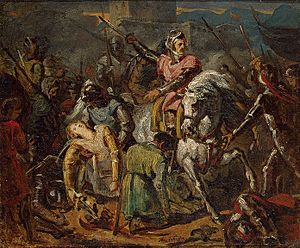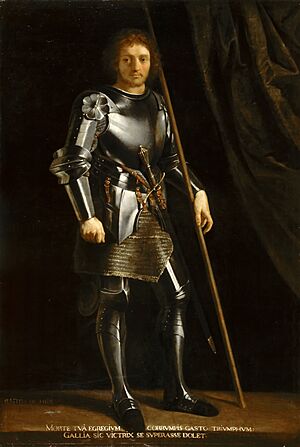Gaston of Foix, Duke of Nemours facts for kids
Gaston de Foix, Duke of Nemours (born December 10, 1489 – died April 11, 1512) was a famous French military leader. He was nicknamed The Thunderbolt of Italy because of his speed and power in battle. Gaston was the nephew of King Louis XII of France. He led the French armies in Italy from 1511 to 1512.
Even though his military career lasted only a few months, he achieved amazing things. Gaston was seen as a brilliant commander, far ahead of his time. He was known for his super-fast marches and bold attacks. These tactics often surprised and confused enemy armies. Gaston is best remembered for his six-month campaign during the War of the League of Cambrai. He died in this war at just 22 years old, during the Battle of Ravenna (1512). This battle was his last great victory.
Contents
Gaston de Foix: A Young Military Genius
Early Life and Family Connections
Gaston de Foix was born in Mazères, in the County of Foix. He was the only son of John of Foix and Marie d'Orléans. His older sister, Germaine of Foix, became the Queen of Aragon. She was the second wife of King Ferdinand II.
Gaston's grandparents included Eleanor of Navarre, who was a queen. His maternal uncle was Louis XII of France, the King of France. This made Gaston a very important person with strong royal connections.
Leading the French Army in Italy
In 1511, Gaston arrived in Italy as a new commander. He was only 21 years old. His arrival brought a lot of energy to the war. French forces had captured the city of Bologna. But a combined army from the Pope and Spain was attacking it. This army was led by Ramón de Cardona, the Viceroy of Naples.
Gaston quickly marched his army to Bologna. He scattered the forces of the Holy League. They had to retreat to Ravenna.
Facing the Holy League
In October 1511, Pope Julius II created the Holy League. This group included Ferdinand of Aragon and the Republic of Venice. Their goal was to take back lands from the Pope. This also meant driving the French out of Italy. So, Gaston now faced attacks from many sides. The Swiss came from the north, the Pope and Aragon from the south, and Venice from the east.
The Swiss captured Bellinzona in December 1511. But Gaston chose not to attack them. He worried that if he left Milan, the people there might rebel. Instead, he strengthened Bologna, which was under attack again. The Swiss eventually left as winter arrived, unable to draw Gaston into a fight.

In February 1512, Gaston left Milan. He went to help Brescia, which Venice was attacking. He defeated the Venetian forces there. It is said that Pope Julius II was so angry when he heard about this defeat that he tore out his beard! Meanwhile, Cardona had retaken most of the Romagna region.
The Battle of Ravenna (1512)
Gaston then made his army march quickly south through the snow. He arrived at Ravenna unexpectedly. He threatened to lay siege to the city. Cardona, who was at Imola, set up his army on marshy ground near Ravenna. Gaston had about 23,000 soldiers and 54 cannons. About 8,500 of his soldiers were German landsknechte. Cardona had around 16,000 troops and 30 cannons. The Ravenna city guard had about 5,000 men. Gaston formally invited Cardona to battle, and Cardona accepted.

The very important Battle of Ravenna took place on April 11, 1512. The Spanish army had their backs to the Ronco River. They had strong defenses and obstacles built by the famous engineer Pedro Navarro. Gaston left 2,000 men to watch Ravenna. He moved the rest of his army against Cardona.
The French army crossed a stream between Ravenna and the Spanish camp. They formed a semicircle around the enemy defenses. Then, they started firing their cannons at the Spanish from the sides. The heavy cannon fire did not hurt the well-protected Spanish foot soldiers much. But the Spanish horse soldiers could not take it anymore. They charged at the French without orders. These charges were easily pushed back. The French then attacked. A bloody fight lasted for about an hour. It was between the German landsknechts and the Spanish in their defenses.
At this moment, two cannons Gaston had sent behind the Spanish lines opened fire. This caused huge damage to the enemy's rear. The Spanish began to retreat. They suffered terrible losses. During the chase, Gaston led a charge of horse soldiers against a retreating Spanish unit. His horse stumbled, he fell, and he was shot and killed. The French lost up to 9,000 soldiers. The Spanish lost almost their entire army. Pedro Navarro was also captured.
Aftermath and Legacy
Even though the French won at Ravenna, Gaston's death was a huge blow. Over a third of his army was also lost. This greatly weakened French power in northern Italy. When the Swiss returned and joined the Venetians, they marched on Milan. The new French commander, Jacques de La Palice, and his discouraged army fled back to France in June.
Interestingly, Ferdinand of Aragon, whose forces Gaston fought at Ravenna, was married to Gaston's sister, Germaine de Foix. She now had Gaston's claim to the Kingdom of Navarre. Ferdinand then invaded Navarre. He was able to conquer and keep all of its Spanish territories.
Gaston's Tomb

A very detailed tomb was ordered for Gaston in Milan. It was made by the workshop of Agostino Busti. Even though it was never fully finished or put together, it is a very important work of art. It is especially key in French Renaissance art. The tomb was planned to have classic-style panels around its base. These panels would show scenes from Gaston's military campaigns. On top, there would be a traditional statue of him lying down. Most of the pieces of this tomb are now on display at the Castello Sforzesco in Milan.
See also
- County of Foix
- Portrait of a Clad Warrior



